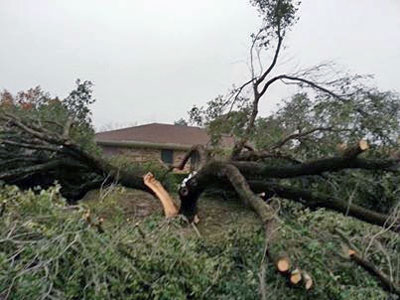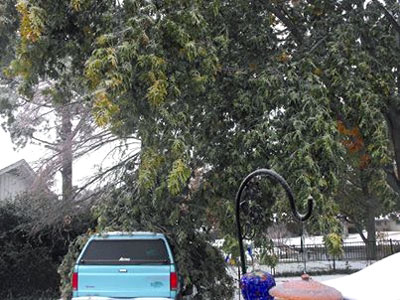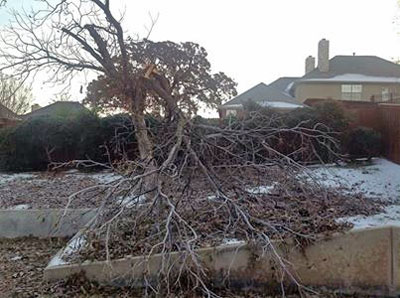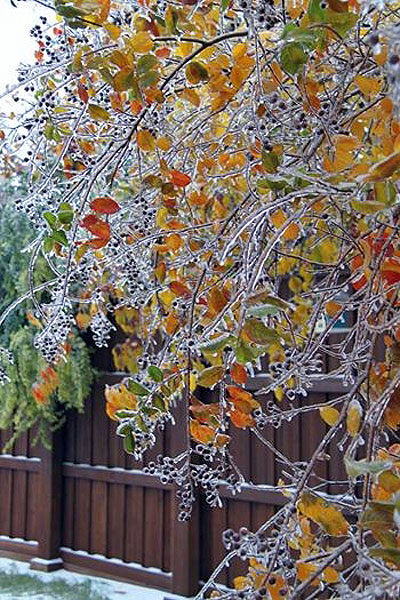Aftermath of the Storm

Lacey oak that once proudly stood guard over the Sperry drive.
Yep. Our trees took a beating in last week’s ice storm. How we work to help them in the next several months will go a long way in determining whether and how fast they recover.
(For those of you in areas that were missed by the ice, you could be next, so please do read through these notes.)
Here are my suggestions of how you approach the questions of “Where am I, and where do I go next?”

Little is left of this live oak. (Photo submitted by one of our Facebook friends.)
• Look at your landscape to determine trees that could lose more branches. If they pose imminent danger, let a certified arborist know. Don’t go near them until you’re sure that they’re safe.
• Concurrent with that, make note of where the utility lines are in relation to any work you might want to do or have done. If you need to contact the electric service provider for advice, don’t hesitate. The companies encourage you to do so.
• Gather up debris such as twigs and broken limbs that litter the ground. You don’t want to be looking up into your trees and trip on a piece that has already fallen.
• Be honest with yourself as you ask, “Is the tree worth saving?” If it’s a Bradford pear that split down the middle, my suggestion would be that it definitely is not. But if it’s a lovely oak that has lost one or two branches, yes, it absolutely is worth the effort.
• At this point, determine what work you can do and which tasks will be saved for a certified arborist.

Falling trees seemed to find many Texas automobiles. (Photo submitted by one of our Facebook friends.)
My suggestions to you…
Do not climb! Unless you’ve been trained in assessing trees’ weaknesses after storms, and unless you’ve been trained in safe climbing techniques, you have no business putting one foot on a ladder. Call in a pro.
Do not try to bring down large branches. Leave that to a certified arborist. They know how to do so without having the weight of the branch peel bark down the side of the trunk. They’ll tie the branch off and safely lower it to the ground piece-by-manageable-piece. They’ll have the equipment. They’ll have the training. They’ll have the patience.
Do not try to fell large trees that have been ruined. You don’t live in the middle of a field. You live near houses and cars and families and friends – and power lines. Certified arborists can bring a large tree down, piece-by-piece, and they can hit a bull’s eye on the ground. That’s money well spent.
Do not try to fill cavities in trunks. That’s rarely a good idea. Certified arborists will know the best approach.
Leave a piece of the branch collar as you trim smaller branches. (The certified arborist will know to do that on the larger ones.) The “branch collar” is the delta of the branch, where it widens out as it intersects with the trunk. If you were to lay a saw flat against the trunk in removing a branch, you would expose a large open wound. If you come out just half an inch (or so), the wound will be much smaller, and the tissue that can heal across the wound will be left in place.
Do not allow weight of falling branches to peel bark off the trunk. If you’ve ever cut a 2×4 on sawhorses, you know that there is always a peel-back when the board falls just before you finish the cut. That’s why you get someone to hold the far end of the board gently, to prevent it from falling. But you’re not going to find anyone willing to hold the far end of a mid-sized tree limb, so you have to take a different route.

Pecan splintered by ice. (Photo submitted by one of our Facebook friends.)
Three steps to successful branch removal
1. Make an undercut one-fourth of the way into the bottom of the branch 12 or 15 inches out from the trunk. Do not cut far enough that the chain saw blade will become bound.
2. Move 3 or 4 inches farther out on the branch (beyond the undercut), and cut completely through the branch from the top downward. The weight of the falling branch will peel the bark on the bottom side of the branch, but only back to your undercut.
3. Cut the remaining 12- or 15-inch piece of the branch at a spot just away from the trunk, as described, to leave the branch collar.
Do you apply pruning sealant/pruning paint? For most tree species, no. They will heal more quickly if you just leave them alone, so that the roll of healing bark can grow in from the sides. However, because oak wilt is a threat to those valuable trees, it’s recommended that all oak cuts larger than a broomstick in size should be protected with a light coating of the black sealant.
Choose a reputable arborist!
Good tree specialists will not knock on doors! Be on the lookout for pickup trucks with brand new magnetic signs proclaiming “tree removal.” Odds are that those people know a lot less about good tree care than you do. Do not hire them!
You’ve seen reference made to “certified arborist” a dozen or more times here already. But who are those people? They are men and women who have achieved that level of licensure through rigorous testing with the International Society of Arboriculture (ISA). The first question you need to ask anyone you’re about to hire to do tree work for you is “Are you ISA certified?” Ask them to show you the validation. Oh, and the second question you probably should ask is “Are you bonded and insured?”
If you do not already have a working relationship with a certified arborist, ask your neighbors which company they use and if they’re satisfied with the results. Ask your favorite independent retail nurseryman. He or she will know the best ones.
Be prepared to wait a couple of weeks. The really good tree service companies have been slammed since last Friday. If they tell you it may be two or three weeks until they can schedule you, that’s absolutely fine. If you have large branches that could cause harm, the arborist may come take those down first and come back for the finish-up work at a later date. That is absolutely fine. No more harm will be done to the trees in the interim, even if it’s a month or two. But do get workman scheduled now, so the work will be done before spring leaf-out.
Replanting
This storm was a fluke. First, it brought a very large amount of ice. The ongoing road and school issues were testimony to that. Second, it came so early in the late fall/early winter that it caught many of our best trees still in leaf. That’s why red oaks (and my beloved Lacey oak) were hurt so badly. Ornamental pears seldom make it more than 10 or 15 years anyway due to their very weak branching, so we could have expected them to go down like flies. And they did.
So what tree species are good for replanting? I’m a firm believer in the trees that have stood the test of time in Texas. Live oaks, red oaks and magnolias may have been hurt by the ice, but they’re still among our finest landscaping trees. Chinquapin oaks and bur oaks seemed to fare very well, and I haven’t seen any damage to Chinese pistachios. Pecans and cedar elms did lose some branches, but they’re still great choices.
There is a list of trees that are likely to show up with weather-related problems sooner rather than later, and we can see many of them on the ground right now: ornamental pears (as in “Bradford”), lacebark elms, silver maples and hackberries, among a few others. Those are good trees to avoid in our replanting.

Fall color still hanging on crape myrtle. (Photo submitted by one of our Facebook friends.)
Crape myrtles
And finally, a word about crape myrtles. I drove about 8 miles of Eldorado Parkway in McKinney last night (main corridor of our Crape Myrtles Trails of McKinney), and I rejoiced as I saw only 20 or 25 of our many thousands of crape myrtles that had suffered severe damage. Our city, as time permits, will cut broken stems back flush with the ground and allow new shoots to grow from that point. It’s actually the very same technique we advise for crape myrtles that have been topped (a barbaric act, whether done by man or by nature): cut the topped trunks completely to the ground and retrain the regrowth.
I hope these notes have been of help. Feel free to forward this on to friends. If you have additional questions, I’m on the air weekends (Saturdays statewide 11-noon on several dozen stations and Sundays 8-10 on WBAP 820AM). Join me on Facebook as well.

